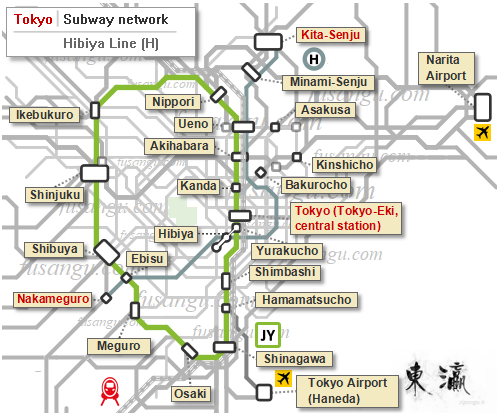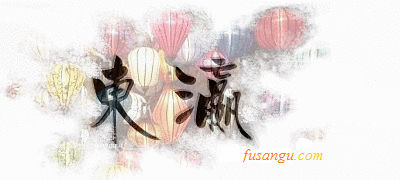
For the purpose of tourism, the Hibiya-sen is among the most useful lines of Tokyo’s subway networks.
The line runs north-south connecting many of the city’s most popular tourist areas such as Ueno, Akihabara, Ginza, Minato, Meguro.
In this page we describe a one-day tour along the Hibiya Line. The article includes a programme suitable for short stays.
The Hibiya Line (Hibiya-sen) is managed by the main subway operator, Tokyo-Metoro.
The line connects many places of interest and serves important stations and transportation hubs.
These are the termini:
-
Minami-Senju, northern terminus, in Arakawa; interchange with Joban Line (JR railway network);
-
Nakameguro, southern terminus, in Meguro.
In the central section, the line runs very close to the Yamanote Line (the railway loop line).
Areas of interest served by the line are the following:
-
Ueno, neighbourhood noted for the prestigious museums and a large park;
-
Akihabara, the “electric town”, a gathering place for otaku and anime and manga buffs;
-
Chuo, central district; the line connects important neighbourhoods, such as Nihombashi and Ginza;
-
Roppongi, a district known for modern art museums, upscale shopping malls and a cosmopolitan night life;
-
Nakameguro, one of Tokyo’s top cherry blossom viewing spots.
It is not possible to visit all these areas in one day, especially if you wish to include visits to museums in your programme.
Recommended itinerary along the Hibiya Line
Below is the outline of a programme that suits well the needs of a first-time visitor. We assume you start your journey in Ueno:
-
8:30 - 12:00: visit to Ueno. Here you can visit Tokyo National Museum and Ueno Park. Not to be missed are Toshogu Shrine and Benten-Do, beautiful religious architectures peacefully set amid the serenity of the park;
-
12:30 - 16:00: lunch break and visit to Akihabara, a little dreamland for those who love anime, manga, cosplay and electronics;
-
16:15 - 18:30: walking tour in Ginza. Aside from the glittering shopping malls, the neighbourhood offers a few traditional shops that preserve traditional productions. Among the products are kimono, Japanese paper, furniture and much more. There are also quite a few small shrines and a large Buddhist temple built in a unusual style, reminiscent of Indian art, Hongwan-Ji Temple.
In the evening
You can conclude your tour in many ways, among which:
-
Clubbing in Roppongi, an area that have catered to foreigners for long time;
-
Viewing cherry blossom in Nakameguro, the area is lit at night in the flowering season;
-
Having dinner in an izakaya near Akihabara, a simple and cheerful way of exploring the ordinary lifestyle of the locals.
Many other choices are possible. Near Roppongi is another cherry blossom spot, Sakura-Koen. Not far are Aoyama Cemetery and Nezu Museum, a great destination for those who are interested in East Asian ancient art and culture.
Near Nakameguro are the Museum of Parassitology and a few temples.
Where to stay
Ueno is served by the Hibiya Line and is a prime choice for lodging. Staying in Ueno allows for easy transfers to the airports, the shinkansen railway stations and every major area of Tokyo.
If you choose to stay in Ueno, you have to book well in advance as most hotels and hostels are quickly sold out.
North of Ueno, around Iriya Station are a few cheap hotels and hostels. Even better to those who travel on a budget is to look for a place to stay in the vicinity of Minami-Senju Station.
Related articles:
Main article: Tokyo 3-day itinerary
Itineraries along the subway lines (Asakusa, Hibiya, Ginza, Marunouchi, Tozai, Mita, Namboku, Yurakucho, Chiyoda, Shinjuku, Hanzomon, Oedo, Fukutoshin)

